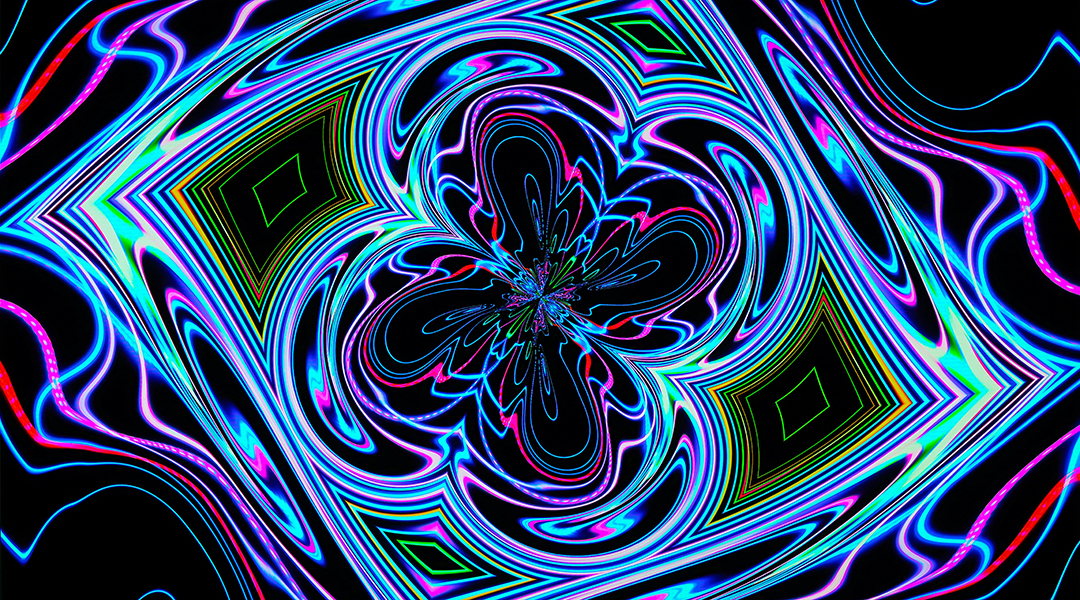Often, when we close our eyes and lights flicker past our faces, a kaleidoscope of patterns might flit across our vision, creating an ephemeral tapestry of color and form. These images can resemble intricate geometric shapes, swirling and morphing in a mesmerizing dance.
A phenomenon first reported over 200 years ago, scientists have finally discovered exactly how flickering lights can create electrical waves that travel through the brain, creating these kaleidoscope hallucinations.
Rasa Gulbinaite, postdoctoral researcher at the Netherlands Institute for Neuroscience, became interested in this topic while studying the effects of rhythm on the brain.
“I am interested in how sensory rhythms around us interact with and affect our brain rhythms,” said Gulbinaite. “Not all rhythms have the same effect, some have a stronger effect by resonating or synchronizing with our brain’s natural frequencies.”
“In this study I was interested in exploring resonance to the flickering light across the entire mouse brain,” she continued.
What her team found was that when mice were shown these flickering lights, they could see activity in parts of their brain that were not directly stimulated. This activation followed patterns that resembled the waves created by sound on a drum surface, as predicted by mathematical models.
Deciphering brain waves
It was neuroscientist Jan Purkinje who first discovered, in 1819, that light flashes can make our brain see these geometric patterns. Since then, scientists have been studying this phenomenon and its therapeutic potential, including ongoing clinical trials testing whether specific flickering lights are able to clear proteins linked to Alzheimer’s disease from the brain.
Still, after over 200 years of research, it remained a mystery how the brain waves created by these rhythmic flashes of light interacted with each other to create visual patterns within the brain
Using electrodes, scientists can measure the electrical activity of the brain when a person is shown flickering lights. However, the human brain has folds, which makes it difficult to locate where a brain signal is exactly coming from. Mice, on the other hand, have smooth brains, making it much easier to precisely measure their brain activity.
To measure their brain activity, Gulbinaite and colleagues genetically engineered mice to introduce a fluorescent molecule into specific neurons located on the surface of their brain. When these neurons were activated, they produced fluorescent light that could be captured with a high-speed camera from outside the skull.
The researchers were particularly interested in the region of the brain responsible for the sense of sight, called the visual cortex. When light hits our eyes, the optic nerve takes that information to the visual cortex, which acts as a map — each location of the visual cortex is linked to a specific position within our visual field.
Whenever the mice were shown a light, the neurons linked to its position would light up with fluorescent light. Only when the light flickered, that response would spread to the surrounding neurons, creating waves that traveled through the whole visual cortex.
“These waves are similar to the ripples made by a rock thrown into a pond,” said Gulbinaite. Interestingly, at certain frequencies, these so-called “traveling” waves would transform into another type of wave known as “standing” waves.
Standing waves usually appear when there is a physical boundary, making traveling waves bounce back and interfere with themselves. They can be found in a skipping rope or on the surface of a drum.
“There seems to be an invisible boundary keeping these waves constrained within the visual cortex and preventing them from going further,” Gulbinaite added.
Understanding the human brain
Mathematical models had previously predicted that standing waves could be responsible for the geometric-shaped hallucinations caused by flickering lights, but this study is the first to provide experimental proof that this is actually the case.
“What’s fascinating is that while we are stimulating only one part of the visual cortex, other parts will be responding. This affects how we perceive everything around us,” said Gulbinaite.
Because we can’t ask them what they are seeing, we don’t know for sure if the mice also hallucinated geometric patterns during the experiment. Yet the researchers have good reason to believe that the same type of waves could be responsible for the hallucinations reported by people shown these flickering lights.
“People report that when the flickering light frequency is higher, they perceive finer hallucinatory patterns. And that is exactly what we also saw in the brains of mice; as the frequency increased, the patterns in the visual cortex became finer,” Gulbinaite explained.
While solving a long-standing mystery, this research opens the door to more questions about the inner workings of the brain. For example, the scientists noticed that at lower light frequencies, other parts of the brain also seemed to respond, meaning that it could be possible for flickering lights to also have effects beyond the visual cortex.
However, measuring brain activity under the surface of the brain, where the visual cortex is located, would require more complex and invasive techniques.
Going forward, Gulbinaite is interested in using computer simulations to predict how the activity of the visual cortex would look like in humans seeing the flickering lights. Matching the simulations to what the participants see could help scientists better understand how different wave patterns affect the geometric shapes seen in these hallucinations.
Research is still ongoing on the potential therapeutic applications of this effect. Some studies have shown these visual hallucinations could have some similarities with the effects of hallucinogenic drugs, such as LSD, for example enhancing our emotional response to music. Specific light flickering frequencies have also shown potential to help with sleep and to fight Alzheimer’s.
Going forward, fully understanding the effect that these flickering lights have on our brains could open the door to new, non-invasive forms of therapy that can alter the brain without the need for drugs or surgery.
Reference: Rasa Gulbinaite, et al., Spatiotemporal resonance in mouse primary visual cortex, Current Biology (2024). DOI: 10.1016/j.cub.2024.07.091
Feature image credit: Ashe Walker on Unsplash














